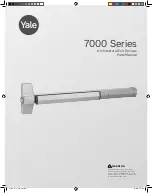
Para la instalación, se deben tener en cuenta
los siguientes puntos:
●
El aire ambiente no debe contener con-
centraciones excesivamente altas de
polvo, gases corrosivos u otras sus-
tancias, siempre y cuando éstos no se
generen durante la soldadura.
Ejemplos de condiciones de funcionamiento
anómalas:
•
Humo corrosivo anómalo
•
Vapor
•
Vaho aceitoso excesivo
•
Vibraciones o golpes anómalos
•
Formación excesiva de polvo
(p. ej. polvo abrasivo)
●
Instale la fuente de corriente de soldadura
robotizada en un entorno limpio y seco
donde circule aire fresco.
●
Si se utiliza en una sala cerrada, se debe
emplear la aspiración de gases de combus-
tión.
●
No coloque la fuente de corriente de solda-
dura robotizada encima o en las proximi-
dades de bases inflamables.
●
La fuente de corriente de soldadura robo-
tizada se debe instalar de manera estable
sobre una superficie recta y plana.
El ángulo de inclinación máximo es de 10º.
●
Si la fuente de corriente de soldadura
robotizada se instala inclinada, ésta debe
protegerse para evitar que se vuelque o
se mueva.
●
La fuente de corriente de soldadura robo-
tizada debe disponer de un espacio libre
de, al menos, 0,5 metros hacia adelante y
hacia atrás para garantizar una refrigeración
óptima.
●
Las rejillas de ventilación no deben cubrirse
nunca.
●
Asegúrese de que el cable de alimentación
de red está suficientemente dimensionado
y protegido.
●
La fuente de corriente de soldadura robo-
tizada no debe apilarse.
I
N
F
O
Procure que la distancia de seguridad
sea lo suficientemente grande como
para que no puedan generarse riesgos
por salpicaduras de soldadura y proteja
el punto de soldadura mediante placas
o cortinas.
Al soldar, pueden generarse vapores y
materias en suspensión perjudiciales
para la salud.
6.
Puesta en marcha
6.1
Instalar la fuente de corriente
de soldadura robotizada
The following points must be taken into consid-
eration during setup:
●
The ambient air must be free of unusually
high concentrations of dust, corrosive gases
or other substances other than those which
occur during welding.
Examples of unusual operating conditions:
•
Corrosive smoke
•
Vapours
•
Excessive oil vapours
•
Unusually vibrations
•
Excessive dust build-up
(e.g. polishing residue)
●
Set up the robotic welding power source in
a clean and dry environment in which fresh
air is circulating.
●
When operating in closed-off rooms, an
exhaust gas extraction system must be used.
●
Do not install the robotic welding power
source on, over or near any flammable
surfaces.
●
The robotic welding power source must
be installed securely on a flat, level
surface.
The maximum angle of inclination is 10°.
●
If the robotic welding power source is
installed at an angle, it must be secured to
prevent it tipping over or sliding.
●
The robotic welding power source must
have a clearance of at least 0.5 meters in
the front and rear in order to guarantee
optimal cooling.
●
The vents must never be covered.
●
Ensure that the mains supply line is
sufficiently dimensioned and protected.
●
The robotic welding power source must not
be stacked.
I
N
F
O
Ensure that the safety distance is far
enough so that no hazards arise from
weld spatter and shield the welding spot
using shields or curtains.
Harmful vapours and suspended partic-
les may occur when welding.
6. Startup
6.1
Setting up the robotic welding
power source
6. Inbetriebnahme
6.1
Aufstellen der
Roboterschweißstromquelle
Folgende Punkte müssen beim Aufstellen
berücksichtigt werden:
●
Die Umgebungsluft muss frei von ungewöhn-
lich hohen Konzentrationen an Staub, korro-
siven Gasen oder anderer Substanzen sein,
soweit sie nicht beim Schweißen entstehen.
Beispiele ungewöhnlicher Betriebsbedin-
gungen:
•
Ungewöhnlicher korrosiver Rauch
•
Dampf
•
übermäßiger Öldunst
•
ungewöhnliche Schwingungen oder Stöße
•
übermäßige Staubungen
(z.B. Schleifstaube)
●
Die Roboterschweißstromquelle in einer
sauberen und trockenen Umgebung auf-
stellen, in der Frischluft zirkuliert.
●
Beim Betrieb in geschlossenen Räumen
muss eine Rauchgasabsaugung verwendet
werden.
●
Die Roboterschweißstromquelle nicht auf,
über oder in der Nähe von brennbare Unter-
lagen stellen.
●
Die Roboterschweißstromquelle muss
standsicher auf einer ebenen Fläche aufge-
stellt
werden.
Der maximale Neigungswinkel beträgt 10°.
●
Wenn die Roboterschweißstromquelle
geneigt aufgestellt wird, muss diese gegen
Umkippen und Verrutschen gesichert
werden.
●
Die Roboterschweißstromquelle muss
nach vorne und hinten einen Freiraum von
mindestens 0,5 Meter haben, um eine opti-
male Kühlung zu gewährleisten.
●
Die Lüftungsgitter dürfen niemals abgedeckt
werden.
●
Stellen Sie sicher, dass die Netzzuleitung
ausreichend dimensioniert und geschützt ist.
●
Die Roboterschweißstromquelle darf nicht
gestapelt werden.
I
N
F
O
Wählen Sie den Sicherheitsabstand
so groß, dass keine Gefahren durch
Schweißspritzer entstehen und schirmen
Sie die Schweißstelle durch Schilde
oder Vorhänge ab.
Beim Schweißen können gesundheits-
schädliche Dämpfe und Schwebstoffe
entstehen.
S c h w e i S S e n
w e l d i n g
w e l d i n g
S o l d a d u r a
S c h w e i S S e n
33
:
:
:
:
















































